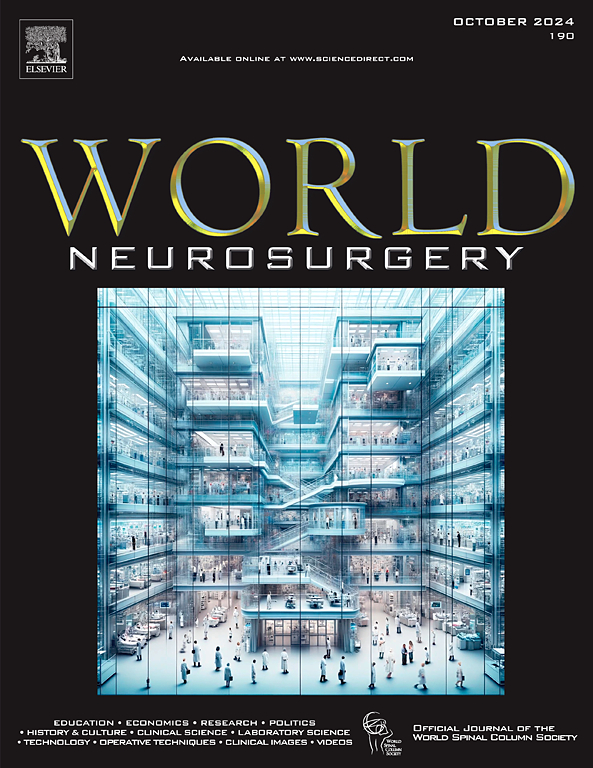短期卧床并非内窥镜颅底手术后静脉血栓栓塞的风险因素。
IF 1.9
4区 医学
Q3 CLINICAL NEUROLOGY
引用次数: 0
摘要
导言:深静脉血栓栓塞症(DVT)会增加术后患者的发病率,而目前的指南并未明确哪些接受内窥镜颅底入路术(EEA)的患者可能会面临更高的风险。这些患者的术后护理通常包括一段时间的非活动期,以防止可能影响颅底重建的一过性 ICP 转移。我们试图确定术后卧床是否会增加 EEA 患者发生血栓栓塞并发症的风险:对2018年7月至2024年5月期间因任何颅底病变而接受硬膜内手术并进行原发性颅底重建的患者进行回顾性病历审查,结果有221名患者符合纳入标准。对患者的人口统计学特征、入路范围、术中漏流率、卧床时间、术后腰椎引流(LD)的存在和时间以及术后机械性VT预防措施的使用进行了单变量和多变量回归:纳入患者的平均年龄为(52.6 ± 16.8)岁,48%为男性,3.6%的患者患有深静脉血栓。90,P=0.14)、卧床时间(OR 1.06,95% CI 0.77-1.27,P=0.60)和是否存在 LD(OR 1.10,95% CI 0.55-2.02,P=0.76)在多变量分析中对术后 VTE 发生率无显著预测作用:结论:EEA术后短期卧床并非术后即刻发生VTE的风险因素。本文章由计算机程序翻译,如有差异,请以英文原文为准。
Short-Term Bed Rest is not a Risk Factor for Venous Thromboembolism After Endoscopic Skull Base Surgery
Background
Venous thromboembolism (VTE) increases morbidity in postoperative patients. No current guidelines identify which patients undergoing endoscopic endonasal approach (EEA) to the skull base may be at increased risk. Postoperative care for these patients often includes a period of inactivity to prevent transient intracranial pressure shifts that may impact skull base reconstruction. We sought to characterize if postoperative bed rest puts patients undergoing EEA at increased risk of developing thromboembolic complications.
Methods
Retrospective chart review of patients undergoing intradural surgery with primary skull base reconstruction for intraoperative cerebrospinal fluid leak via EEA for any skull base pathology between July 2018 and May 2024 yielded 221 patients who met inclusion criteria. Univariate and multivariable regressions were performed with patient demographics, extent of approach, intraoperative leak flow rate, bed rest duration, presence and length of postoperative lumbar drainage, and use of postoperative mechanical VTE prophylaxis.
Results
Mean age of included patients was 52.6 ± 16.8 years, 48% of patients were male, and 3.6% of patients had DVTs. Age (odds ratio [OR] 1.01, 95% confidence interval [CI] 0.96–1.06, P = 0.83), sex (OR 0.40, 95% CI 0.05–2.19, P = 0.31), body mass index (OR 0.98, 95% CI 0.87–1.07, P = 0.74), extended approach (OR 0.80, 95% CI 0.13–4.36, P = 0.80), cerebrospinal fluid leak flow rate (OR 5.71, 95% CI 0.77–118.90, P = 0.14), bed rest duration (OR 1.06, 95% CI 0.77–1.27, P = 0.60), and presence of lumbar drainage (OR 1.10, 95% CI 0.55–2.02, P = 0.76) were not significant predictors of postoperative VTE incidence on multivariable analysis.
Conclusions
Short-term bed rest after EEA is not a risk factor for development of VTE in the immediate postoperative period.
求助全文
通过发布文献求助,成功后即可免费获取论文全文。
去求助
来源期刊

World neurosurgery
CLINICAL NEUROLOGY-SURGERY
CiteScore
3.90
自引率
15.00%
发文量
1765
审稿时长
47 days
期刊介绍:
World Neurosurgery has an open access mirror journal World Neurosurgery: X, sharing the same aims and scope, editorial team, submission system and rigorous peer review.
The journal''s mission is to:
-To provide a first-class international forum and a 2-way conduit for dialogue that is relevant to neurosurgeons and providers who care for neurosurgery patients. The categories of the exchanged information include clinical and basic science, as well as global information that provide social, political, educational, economic, cultural or societal insights and knowledge that are of significance and relevance to worldwide neurosurgery patient care.
-To act as a primary intellectual catalyst for the stimulation of creativity, the creation of new knowledge, and the enhancement of quality neurosurgical care worldwide.
-To provide a forum for communication that enriches the lives of all neurosurgeons and their colleagues; and, in so doing, enriches the lives of their patients.
Topics to be addressed in World Neurosurgery include: EDUCATION, ECONOMICS, RESEARCH, POLITICS, HISTORY, CULTURE, CLINICAL SCIENCE, LABORATORY SCIENCE, TECHNOLOGY, OPERATIVE TECHNIQUES, CLINICAL IMAGES, VIDEOS
 求助内容:
求助内容: 应助结果提醒方式:
应助结果提醒方式:


